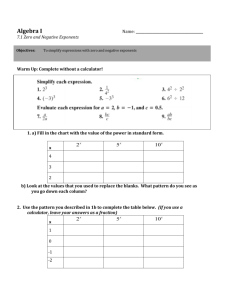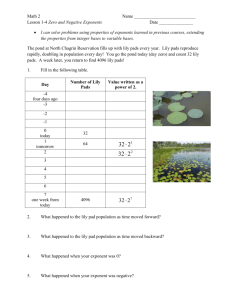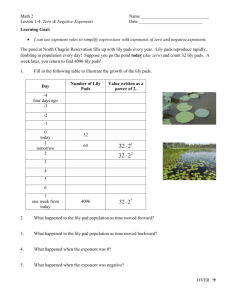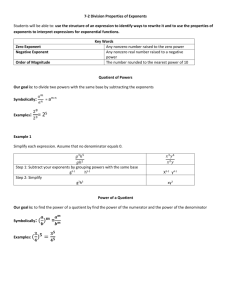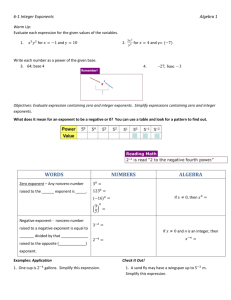Lesson 1-4 Zero and Negative Exponents
advertisement
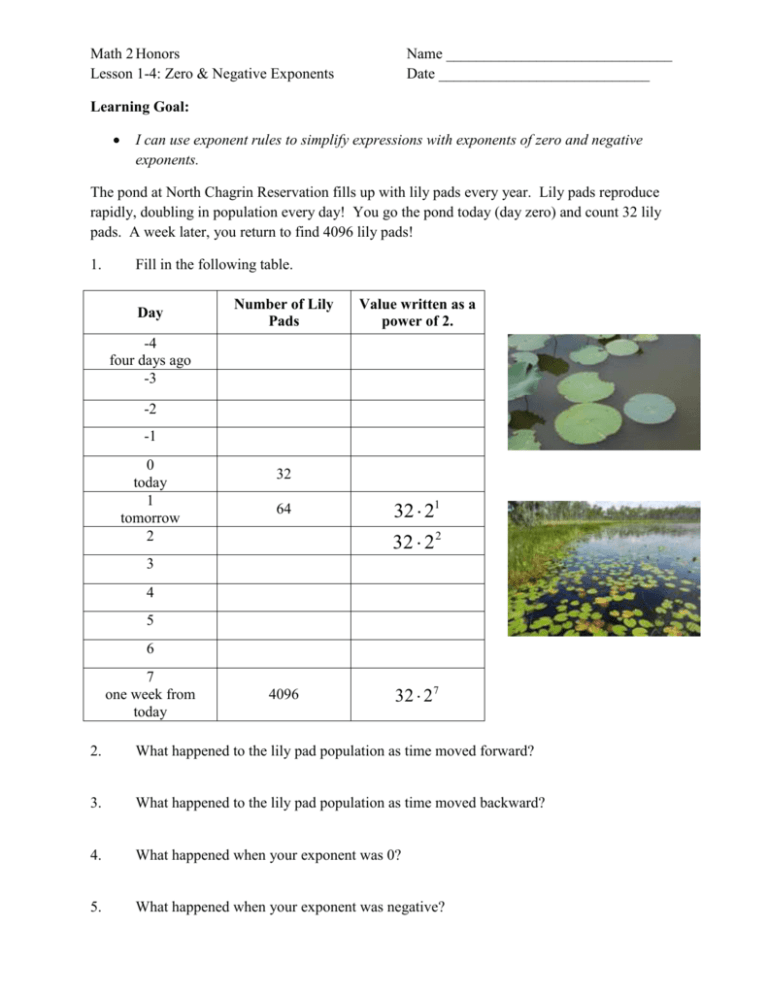
Math 2 Honors Lesson 1-4: Zero & Negative Exponents Name ______________________________ Date ____________________________ Learning Goal: I can use exponent rules to simplify expressions with exponents of zero and negative exponents. The pond at North Chagrin Reservation fills up with lily pads every year. Lily pads reproduce rapidly, doubling in population every day! You go the pond today (day zero) and count 32 lily pads. A week later, you return to find 4096 lily pads! 1. Fill in the following table. Day Number of Lily Pads Value written as a power of 2. -4 four days ago -3 -2 -1 0 today 1 tomorrow 2 32 64 32 21 32 2 2 3 4 5 6 7 one week from today 4096 32 2 7 2. What happened to the lily pad population as time moved forward? 3. What happened to the lily pad population as time moved backward? 4. What happened when your exponent was 0? 5. What happened when your exponent was negative? Your parents bought you a used car today that is five years old & fully loaded! You figure you’ll keep the car for about four years and then sell it for something newer in college. You find out that cars typically depreciate by 20% every year, meaning that they lose value as time goes on. That also means that they retain 80% of their value each year. You find out that your parents paid $10,000 for the car. 6. Fill in the following table. Year Value of Car Value written as a power of 0.80 -5 year the car was made -4 -3 -2 -1 0 today 1 $10,000 10,000(0.80)1 2 3 4 year you think you’ll sell it 10,000(0.80)4 7. What happened to the value of the car as time moved forward? 8. What happened to the value of the car as time moved backward? 9. What happened when your exponent was 0? 10. What happened when your exponent was negative? 11. Filling out the tables on the previous two pages led to some pretty interesting properties of exponents. First, let’s explore what happens when we have an exponent of zero. 32 20 _____ 12. 10,000(0.80)0 ____________ 20 ______ (0.80)0 ______ Let’s see what happens when we raise other numbers (bases) to the power of 0. 50 _____ 61160 _____ x 0 _____ 2 0 _____ 89 0 _____ 0 _____ 13. ZERO POWER PROPERTY: When b is any base and b 0 , b0 _____ 14. Evaluate the following. 21 _____ 15. 16. 23 _____ 24 _____ Now let’s explore what happens when we have a negative exponent. 32 21 _____ 32 22 _____ 32 23 _____ 32 24 _____ 1 32 _____ 2 1 32 _____ 4 1 32 _____ 8 1 32 _____ 16 So what can we conclude from the above results? Answer the following using fractions only! 21 _____ 17. 22 _____ 22 _____ 23 _____ 24 _____ Let’s see what happens when we raise other numbers (bases) to negative exponents. Write your answers as simplified fractions. 31 _____ 82 _____ 43 _____ 53 _____ 18. Let’s convert our answers from above to fractions with positive exponents. Fill in the blanks. 1 31 3 19. 1 82 1 43 8 53 1 5 4 One conclusion we can draw about negative exponents is… NEGATIVE EXPONENTS PROPERTY: When b is any base and b 0 , b x 1 b In the used car problem, we multiplied the value of the car by 0.80, because even though the car lost 20% of its value, it retains 80% of its value each year. 80% can also be written as the 4 fraction . 5 20. Simplify the following using properties discovered in Lesson 1-3. Write your answers as simplified fractions. 1 4 5 2 4 5 ______________ 3 ______________ 4 5 4 ______________ 4 5 ______________ In the used car problem, when we went back in time, the value of the car grew, but not by 20%. The value of the car grew by a factor of 1.25 (25% growth rate).† 1.25 can also be written as the 5 . 4 fraction † Ask your teacher if you’re curious why this is. 21. Simplify the following. Write your answers as simplified fractions. 1 4 5 22. ______________ 3 ______________ 4 5 4 ______________ 4 5 ______________ Let’s convert our answers from above to fractions with positive exponents. Fill in the blanks. 1 5 4 5 4 23. 2 4 5 2 5 4 5 4 3 5 4 5 4 The other conclusion we can draw about negative exponents is… 4 5 4 5 4 NEGATIVE EXPONENTS PROPERTY: When a and b are not equal to zero, 24. a b x b a Simplify the following. Use only positive exponents in your answers. 1 x y 2 2 ______________ a b ______________ 5x 7y 3 2h j ______________ ______________ PRACTICE: Simplify completely. Leave your answers as fractions. No negative exponents! 1.) 5 3 2.) 7 2 3.) 6 1 4.) b 7 5.) 2 5 6.) 3 2 7.) a b 8.) x 2y 9.) 19 0 10.) 7 11.) y0 12.) abcdefg 4 1 3 8 0 0 What if a negative exponent appears in the bottom of a fraction? 1 23 2 3 1 1 x5 x 5 1 4 b 4 c 4 b c 4 b4 c Simply put, if you get a base with a negative exponent in the denominator, move it to the numerator with a positive exponent. Simplify completely. Leave your answers as fractions. No negative exponents! 13.) 1 y 6 14.) 1 8 3 15.) x 7 y 5 16.) 23 w6 x 4 y 5 z 2




